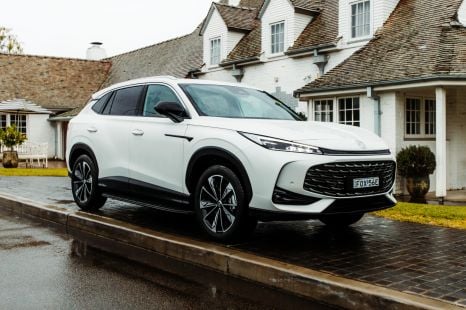

James Wong
3 Days Ago
Turbo. It's an evocative word for motoring enthusiasts, symbolising performance and technical sophistication.

Contributor
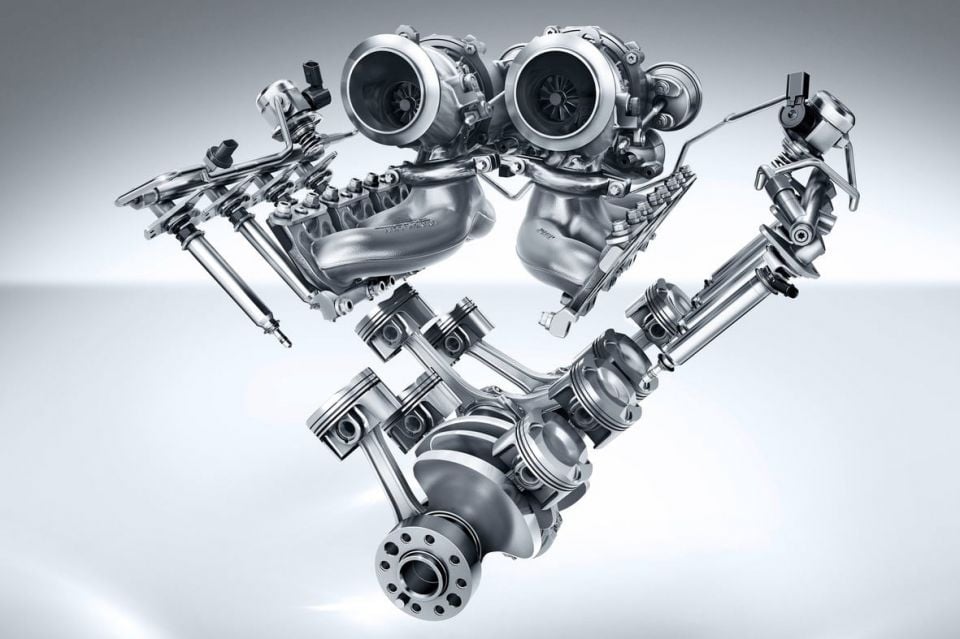

Contributor
From a button to make your computer faster in the 90s, to the top trim level on an electric Porsche, the word turbo has expanded from its automotive origins to describe anything that’s fast.
But what is it about turbocharging that makes it special enough to have such widespread usage?
Turbochargers are used to increase power and torque in internal-combustion engines.
A turbocharger design was first patented in 1915 by engineer Alfred Buchi, with applications for turbochargers in the early 20 century extending to passenger ships and aircraft such as the WWII P-38 Lightning used by the US Air Force.

European automotive manufacturers in the mid-20 Century typically led the the introduction of new technical innovations, but the first commercially-available turbocharged car came from General Motors.
Oldsmobile partnered with industrial turbocharger manufacturer Garrett to produce a turbocharged 3.5L V8 engine creatively named the “Jetfire Turbo-Rocket V8” for its 1962 F85 Cutlass coupe.
The turbocharger aimed to replicate the power and torque of a larger displacement engine without the corresponding fuel consumption.
In order to achieve full power, Jetfire owners had to fill the car with a second tank of liquid known as ‘rocket fluid’ to prevent engine knock. Failing to do so made the car operate in low-power mode.
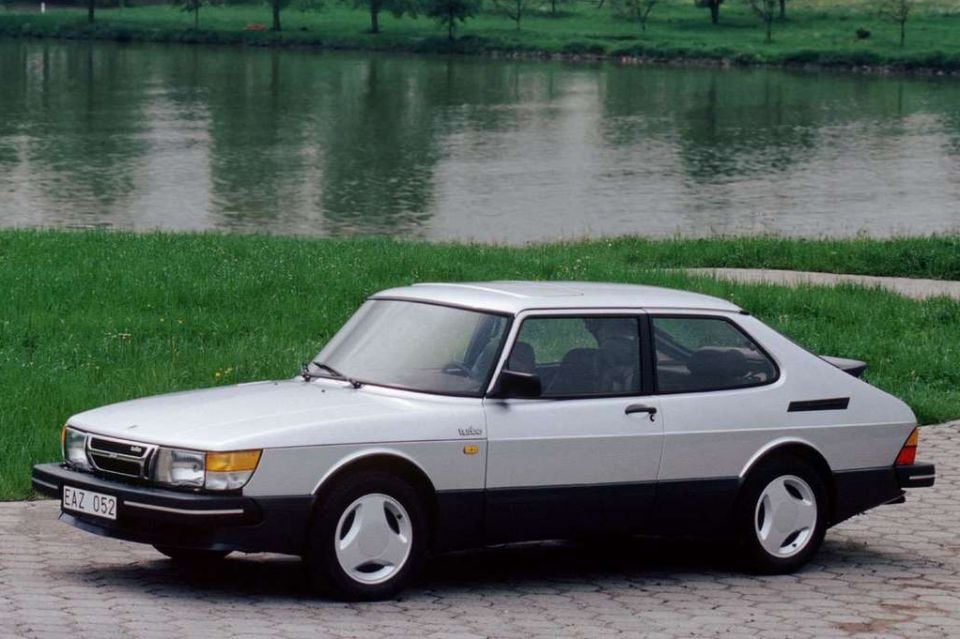
Saab perhaps made the greatest advances in turbocharger technology for daily use during the late ’70s and early ’80s. Models such as the 99 and 900 Turbo – which debuted innovations such as a wastegate to manage pressure and technologies to prevent engine knock – improved turbocharger reliability and cut maintenance costs.
Saab was able to prove turbo engines could offer the performance of larger engines without a fuel economy penalty.
Porsche has also made a significant contribution to turbocharging. Initially featuring on the 917/30 race car, turbochargers made their Porsche production debut in the famed 1974 911 (930) Turbo.
Since then, it has consistently used turbocharging to differentiate its range-topping models from less-powerful variants.
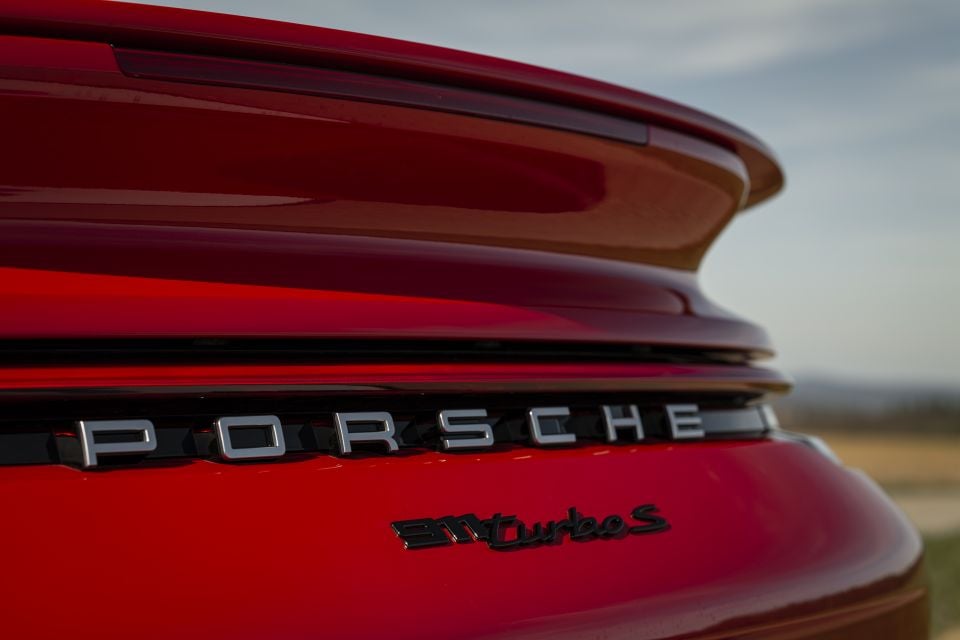
Now, the range-topping version of the Taycan electric car uses the Turbo S badge to highlight its performance – despite having not using or having any technical relationship with turbocharging.
As a quick aside, a piston-based internal-combustion engine works by mixing air and fuel together.
The piston moves up and down within a cylinder (the combustion chamber) in a cyclical process, over four steps or ‘strokes’ (hence four-stroke engine).
The piston is connected to a rotating crankshaft driving the wheels through a transmission and various differentials.
During the intake stroke, the piston draws air into the combustion chamber; simultaneously, fuel is also added.
In the compression stroke the piston moves upwards, reducing the volume of the combustion chamber and compressing the air/fuel mixture. A spark from a spark plug (in petrol engines, see below for diesel) ignites the compressed mixture during the combustion stroke, pushing the piston downwards and rotating the crankshaft.
As the waste air/fuel mixture exits during the exhaust stroke, the piston returns to the top of the cylinder before the cycle repeats.

A turbocharger increases the amount of air entering into the combustion chamber. More air in the combustion chamber means more fuel that can be burned – and faster. Consequently, an engine can generate more power.
A turbocharger consists of three parts: a turbine, an impeller known as a compressor, and a charge air cooler (also known as an intercooler).
The turbocharger is powered by hot exhaust gases emitted from the engine during the combustion process.
The exhaust gases discharged from the engine are piped to the turbine, which makes it spin at high speed, up to 150,000RPM. A connecting rod joins the turbine to the compressor, and ensures the compressor spins at the same rate as the turbine. The compressor is an impeller that acts to draw air into the engine.
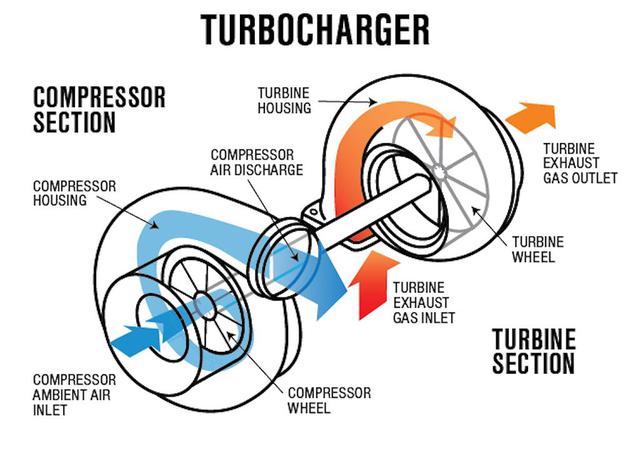
Known as forced induction, this contrasts directly with the naturally aspirated, atmospheric air intake of a non-turbocharged engine (where air is pulled in through the suction force of the piston), and enables the turbocharged engine to draw air in at a far greater rate.
However, drawing air more quickly through the same constricted space squeezes the air, increasing its temperature. Warmer air molecules have more energy, are spaced farther apart, and are less dense.
Less dense air means less air entering the combustion chamber per unit of time. An intercooler solves this density problem by passing the warmer air through a series of cooling fins. Cooler air from outside mingles with this compressed air and draws heat away.
The intercooler makes the turbocharging process more efficient by lowering air temperature and increasing density, allowing more air to enter the combustion chamber.
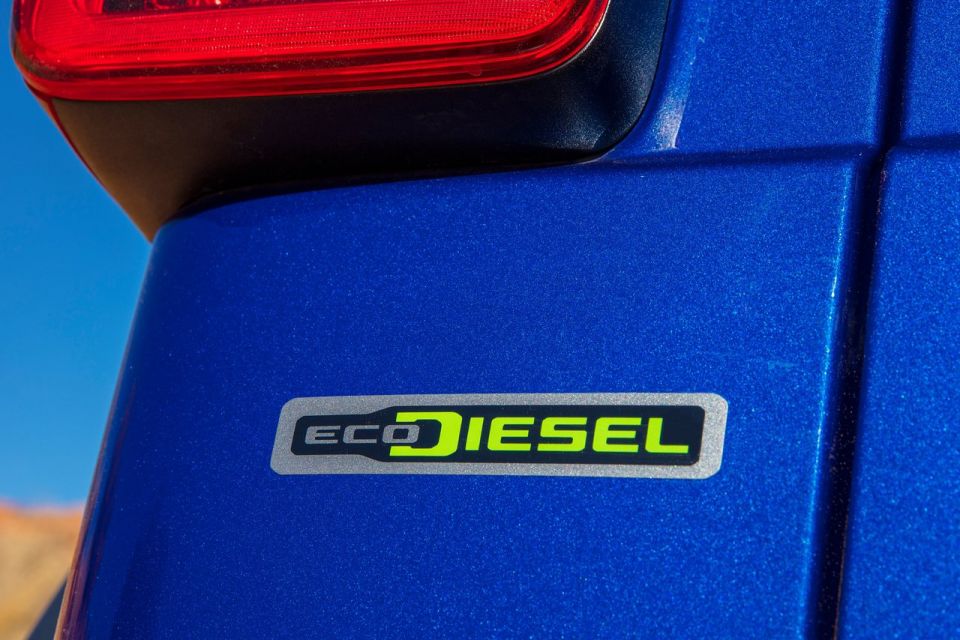
As opposed to petrol engines, which are commonly available in both naturally-aspirated and turbocharged forms, diesel engines today are almost exclusively turbocharged.
This is due to how diesel engines ignite the air/fuel mixture. Unlike petrol engines, which use a spark to ignite the air/fuel mixture, diesel engines ignite fuel through the generation of high temperatures and pressures within the combustion chamber.
This means a diesel engine requires more air than a petrol engine to produce the same level of power, necessitating a turbo.
The turbine powering a turbo compressor is dependent on the flow and amount of exhaust gas produced by the engine. At low engine speeds, the engine produces less exhaust gas. As the turbine spins more slowly, the compressor draws less air in and little (or no) boost is provided.
When the driver depresses the accelerator pedal in a turbocharged car, a ‘lag’ is felt as the engine gradually increases its RPMs to provide enough exhaust gas to adequately power the turbo and provide boost. This sensation is referred to as turbo lag.
Manufacturers have introduced various solutions to reduce the problem of turbo lag and provide more linear power delivery. The airflow principles behind these systems are perhaps best described using a windmill analogy, where the windmill is analogous to the turbine within a turbocharger.
A sequential turbo uses a combination of a smaller (less voluminous) turbocharger in combination with a larger counterpart.
A smaller windmill is easier to spin than a larger one when it’s less windy, but when it’s windier, a larger windmill can provide more power.
Similarly, a sequential system makes use of a smaller turbo at low engine RPMs when airflow is low, with its larger companion taking over to provide more boost at higher RPMs when there is a greater flow of exhaust gas.

A variable-geometry turbo is like a windmill that can change its size depending on how windy it is to produce a consistent level of power.
The technology aims to directly regulate the speed of the exhaust gas entering the turbine, in order to minimise spool-up time and provide a consistent level of boost regardless of engine RPM.
A variable geometry turbo functions through the placement of several vanes around the exhaust turbine. These pivot in response to the airflow coming into the turbocharger. When there is a low exhaust gas flow at slow engine speeds, the vanes adopt a narrower position trading volume for speed, by squeezing the air at a high velocity into the turbine, allowing it to spool up and spin more quickly.
At a high engine RPM there is a greater exhaust gas airflow and the exhaust gas velocity does not need to be increased. Therefore, the vanes open up ensuring the turbine spins at the same rate.
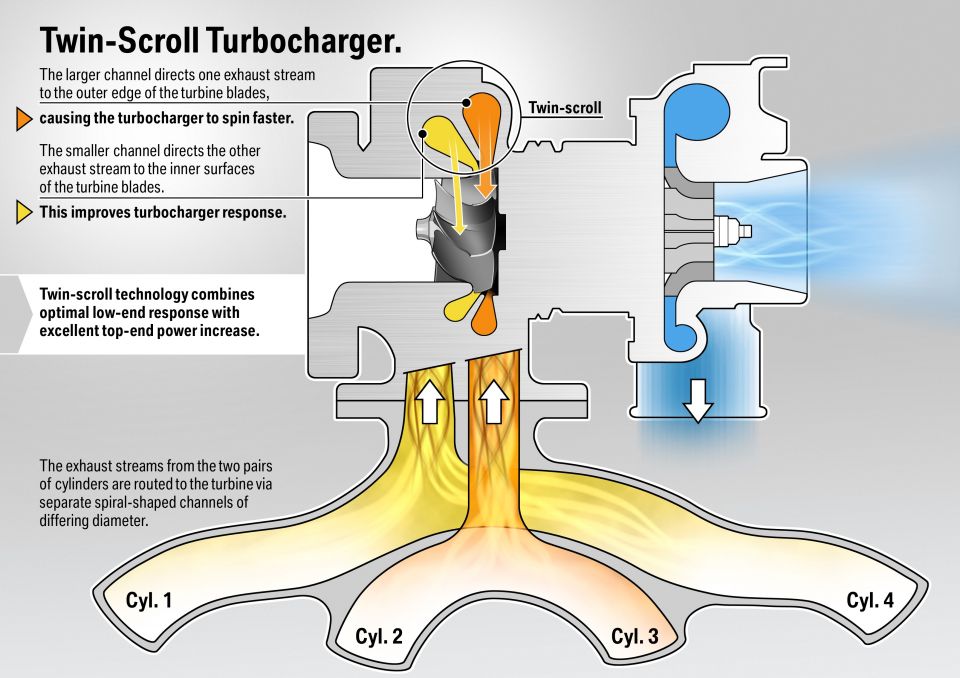
Twin-scroll turbos rely on the principle that multiple-cylinder combustion engines (such as typical four, six, or eight-cylinder engines) don’t fire at the same time. Instead, to ensure a smooth operation, a sequential firing order, such as cylinders 1-3-4-2 for a four-cylinder engine, is used.
A twin-scroll turbo takes advantage of this principle to achieve the same goal as a variable geometry turbocharger.
Differently-sized compressed-air flow channels (‘scrolls’) feed air to the cylinders based on their firing order.
A particular channel could have a smaller volume to increase the velocity of air passing through at lower engine speeds, while an accompanying channel enables the greater volume of exhaust gas generated at higher speeds to efficiently flow into the turbine.
Additionally, the channels may be positioned to direct air at separate parts of the turbine blades to further increase efficiency. These channels control airflow to the turbine in an attempt to negate lag and maximise the boost provided at higher RPMs.
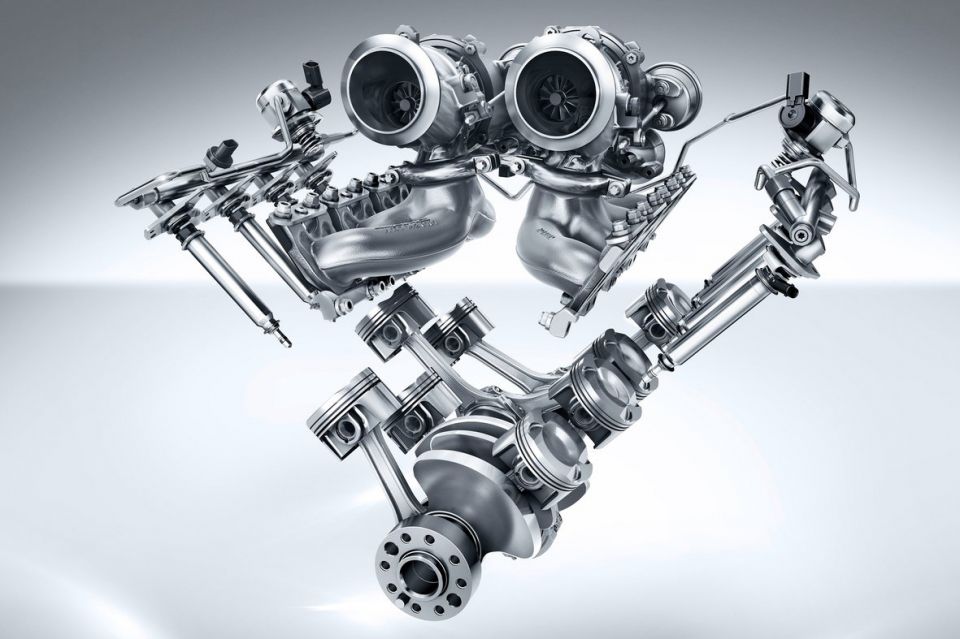
This solution is beneficial specifically for V6, V8, V10 or V12 cars as compared to a flat, or inline cylinder layout.
Mercedes-AMG pioneered the technology in its vehicles, headed by the AMG GT sports car.
In a hot V, the turbocharger is housed in the engine block (typically between the cylinders) rather than outside of the engine. The key benefit it provides stems from packaging.
Placing the turbochargers between combustion chambers significantly reduces the piping, and therefore the distance exhaust gases and air from the compressor travels before flowing through the turbocharger.
With air flowing at the same speed, less distance means less time for less lag.
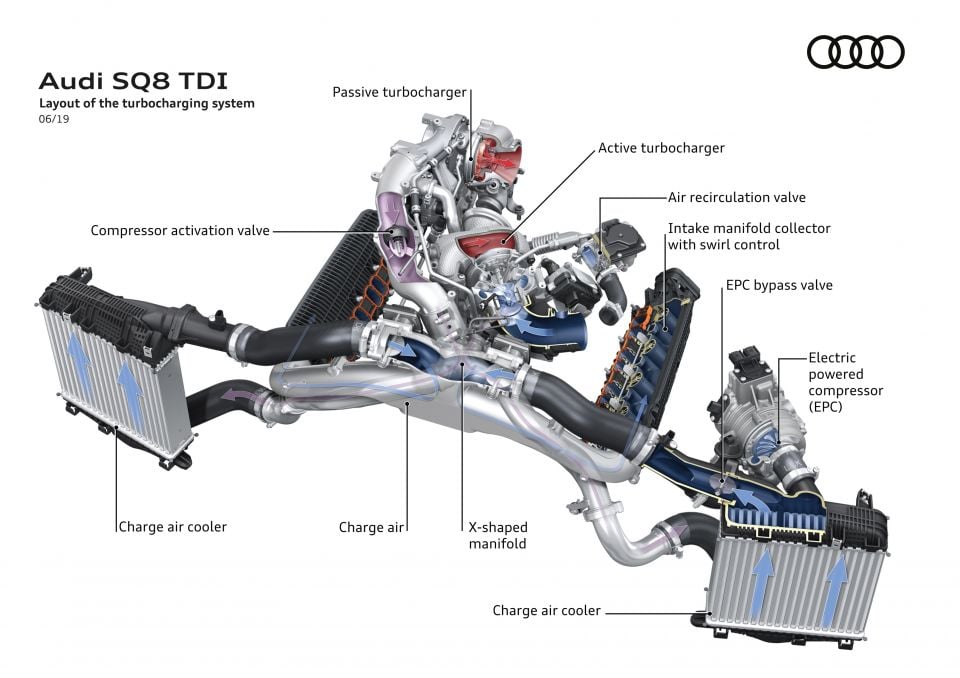
Electric turbos are perhaps the most foolproof way to remove turbo lag from the equation.
By powering the compressor with an electric motor, electric turbos remove the reliance on the exhaust turbine speed to initially draw air into the combustion chamber.
The compressor can run from standstill without waiting for sufficient exhaust gas for the turbine to spin, thereby providing instant boost before the conventional turbochargers take over at higher speeds.
This system is featured in models such as the new Audi SQ8 TDI.
Image credits: https://www.stringtrimmersdirect.com/,


James Wong
3 Days Ago
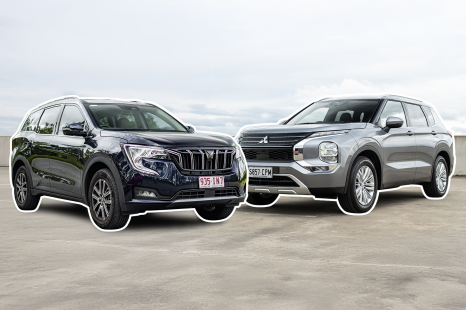

Andrew Maclean
3 Days Ago


Max Davies
3 Days Ago


Max Davies
2 Days Ago


Josh Nevett
2 Days Ago


Max Davies
1 Day Ago